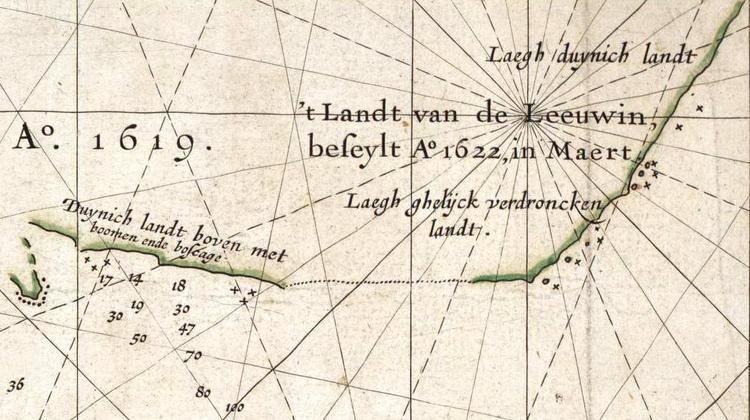 | ||
Leeuwin ("Lioness", also spelt "Leeuwine" in some Dutch East India Company (VOC) documents) was a Dutch galleon that discovered and mapped some of the southwest corner of Australia in March 1622. In this way it became only the seventh European ship to sight the continent.
Unfortunately the Leeuwin's logbook has been lost, so very little is known of the voyage. For example, it is not known who captained the ship. However, VOC letters indicate that the voyage from Texel to Batavia took more than a year, whereas other vessels had made the same voyage in less than four months; this suggests that poor navigation may have been responsible for the discovery. The same is suggested by the 1644 instructions to Abel Tasman, which states that
"[I]n the years 1616, 1618, 1619 and 1622, the west coast of the great unknown South-land from 35 to 22 degrees was unexpectedly and accidentally discovered by the ships d'Eendracht, Mauritius, Amsterdam, Dordrecht and Leeuwin, coming from the Netherlands."
The land discovered by the Leeuwin is recorded in Hessel Gerritsz' 1627 Caert van't Landt van d'Eendracht (Chart of the Land of Eendracht). This map includes a section of coastline labelled 't Landt van de Leeuwin beseylt A° 1622 in Maert ("Land made by the ship Leeuwin in March 1622"), which is thought to represent the coast between present-day Hamelin Bay and Point D'Entrecasteaux. Portions of this coastline are labelled Duynich landt boven met boomen ende boseage ("Dunes with trees and underwood at top"), Laegh ghelijck verdroncken landt ("Low land seemingly submerged") and Laegh duynich landt ("Low land with dunes").
Later voyages
In 1654, the Leeuwin was part a six ship fleet which departed Batavia for the Netherlands. The fleet consisted of VOC ships the Phenix, Orangie, Salamander, Leeuwin, Coningh Davidt and Avontsterre ("Avonster"). The convoy departed the Sunda Strait on 24 January 1654 and passed the Cape of Good Hope on 27 March and anchored at St Helena in the South Atlantic Ocean on 18 March. The Leeuwin arrived in the Netherlands (probably at Texel) on 30 August 1654. She departed there for the return voyage to Batavia on 10 December 1654.
Ongoing conflicts during the Dutch-Portuguese War in 1656 saw the Leeuwin called into a blockade of the strategic port of Bantam at the western end of Java during July. In August, the blockading fleet was moved to the west coast of India for another blockade of the Portuguese held port of Goa. The Leeuwin at this time was under the command of Jan Lucasz and had a crew of 86. She was used to cart stone ballast to other ships in the blockade.
In July 1658 she was used to ferry 500 people, including women and children from Galle in Ceylon (Sri Lanka) to Batavia. During 1659 the Leeuwin was involved in the trade of areca nuts from Galle to the Coromandel Coast and Malacca.
